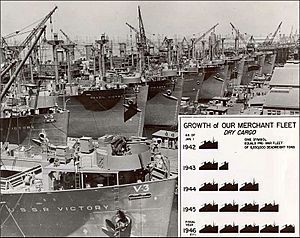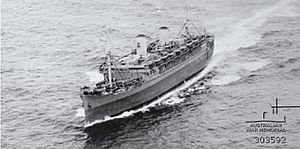War Shipping Administration facts for kids
The War Shipping Administration (WSA) was a special US government agency created during World War II. Its main job was to get and manage all the civilian ships the United States needed for the war. The WSA worked closely with the United States Maritime Commission. The Maritime Commission built the ships, while the WSA decided where they would go. This included sending ships to the Army, the Navy, or for other civilian needs. Vice Admiral Emory S. Land led both agencies to make sure they worked well together.
Contents
Why the WSA Was Created
During World War II, the US needed many ships. There weren't enough ships, and some had to be taken out of service. They needed to be changed or armed for war. This was a big worry for the President. He wanted to make sure all available ships were used in the best way.
So, right after the US joined the war, President Franklin D. Roosevelt created the Strategic Shipping Board. This board included important leaders like the head of the Maritime Commission, the Army Chief of Staff, and the Chief of Naval Operations. But this board didn't always work well. Different groups had different ideas.
There was also a need to work closely with the British Ministry of War Transport. This British group already managed their country's merchant ships. They needed to coordinate all Allied merchant shipping together.
How the WSA Started
On February 7, 1942, President Franklin D. Roosevelt officially created the WSA. He did this with an order called Executive Order No. 9054. The WSA was set up as a separate part of the United States Maritime Commission. The Maritime Commission had been started in 1936. It was in charge of designing and building merchant ships. This included making famous ships like the Liberty ships and Victory ships.
Thanks to these efforts, the US fleet grew very large. It had about 3,500 cargo ships and over 900 fast oil tankers.
How the WSA Operated
The Maritime Commission and the WSA worked very closely. Vice Admiral Emory S. Land was in charge of both. He explained their relationship in a report to the President in 1943:
The Maritime Commission was first set up to control all shipping and shipbuilding. But when the US entered the war, a special agency was needed. This new agency would handle the daily problems of war shipping. That's why the War Shipping Administration was created on February 7, 1942. The WSA took over almost all the Maritime Commission's main jobs, except for building ships. So, the WSA became the government's ship operating agency, and the Maritime Commission was its shipbuilding agency.
WSA's Responsibilities
The WSA had a lot of power and many important jobs. In the same report, Land described what the WSA was responsible for:
- Buying or taking over ships for itself, the Army, Navy, or other government groups.
- Repairing, arming, and protecting WSA ships and Allied ships received through Lend-Lease.
- Changing ships into troop transports, hospital ships, or for other special uses.
- Training and providing people to work on the ships.
- Operating, loading, unloading, and generally controlling how these ships moved.
- Managing marine and war risk insurance laws and money.
- Controlling port facilities and related tasks.
With this power, the WSA decided which ships would carry cargo for trade, the Army, or the Navy. Many Army ships and Navy transports were assigned by the WSA. The WSA also directly operated ships to support the military and civilian needs. Some of the most famous ships operated by the WSA were large, fast troop transports. These ships could often sail without needing a military escort. They included ships like the Argentina, Brazil, John Ericsson, Lurline, Mariposa, Monterey, and Uruguay.
The WSA also worked closely with the British Ministry of War Transport. They did this through a group called the Combined Shipping Adjustment Board. Their goal was to make sure all available ships and their cargo space were used as efficiently as possible.
The WSA also created and enforced better ways to use ship space. They made sure ships weren't used in wasteful ways by businesses or the military.
After the War
After World War II ended, WSA ships were used for a huge task. They carried millions of soldiers and sailors home from overseas. This mission was called Operation Magic Carpet. By December 1, 1945, over 3,500,000 service members had been brought home.
On September 1, 1946, the WSA's jobs were given back to the Maritime Commission. The WSA agency then closed down.



